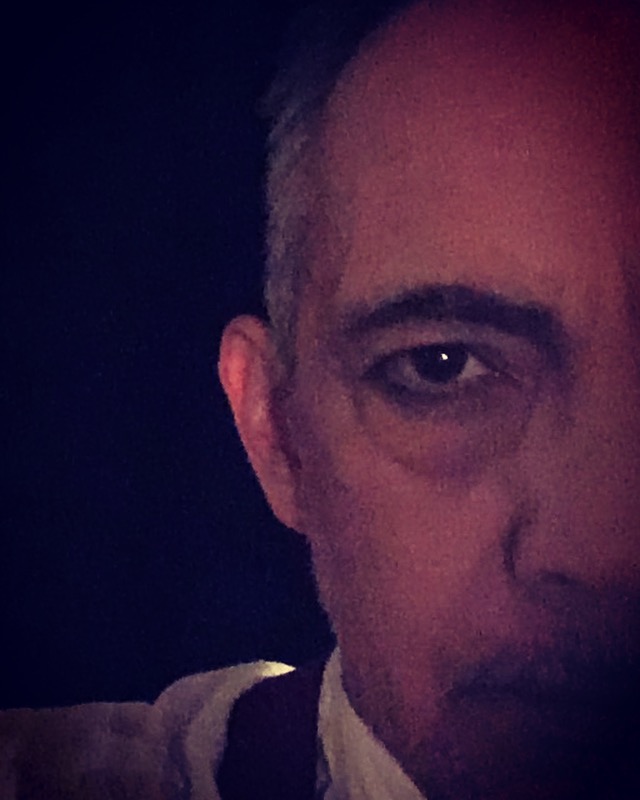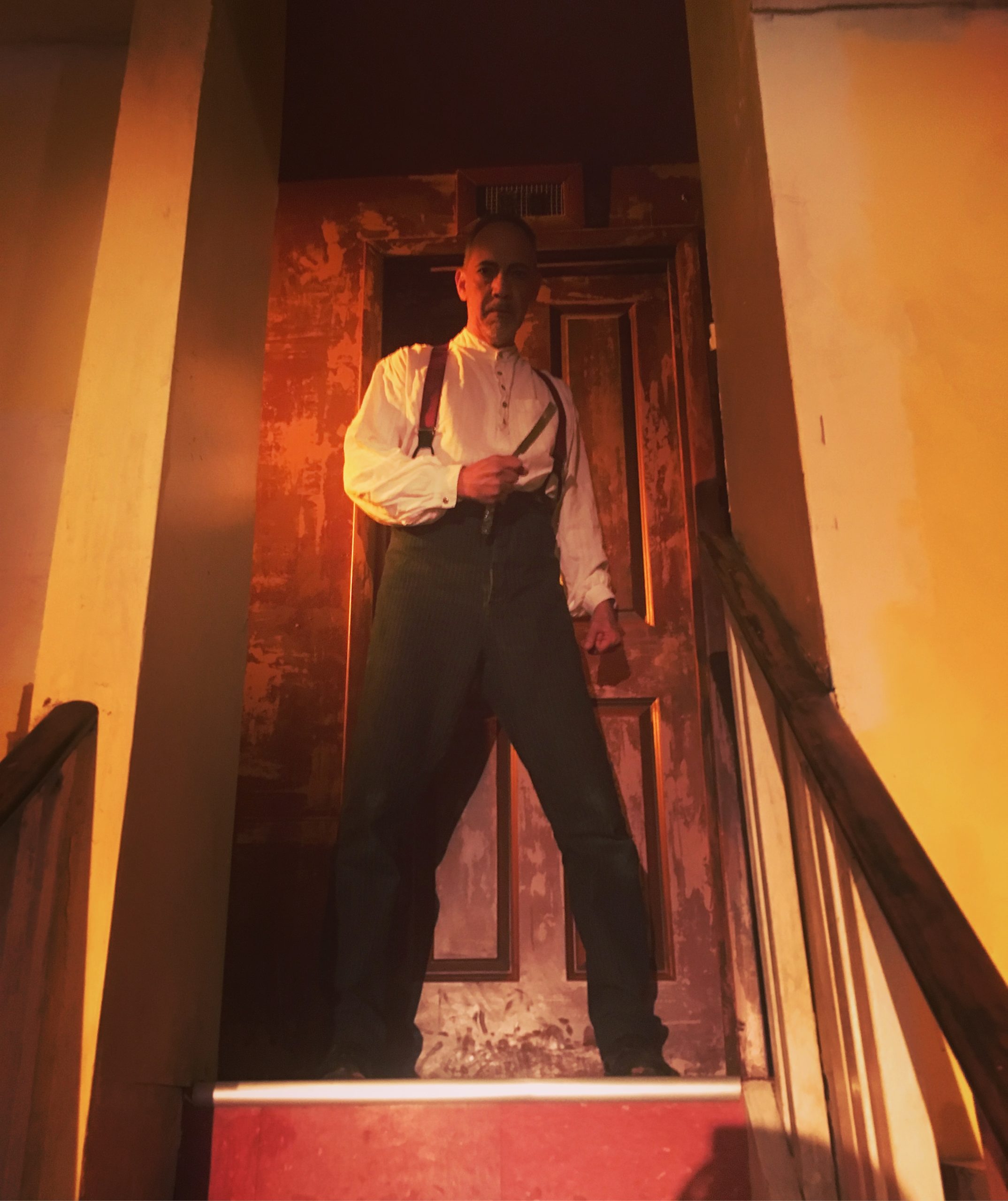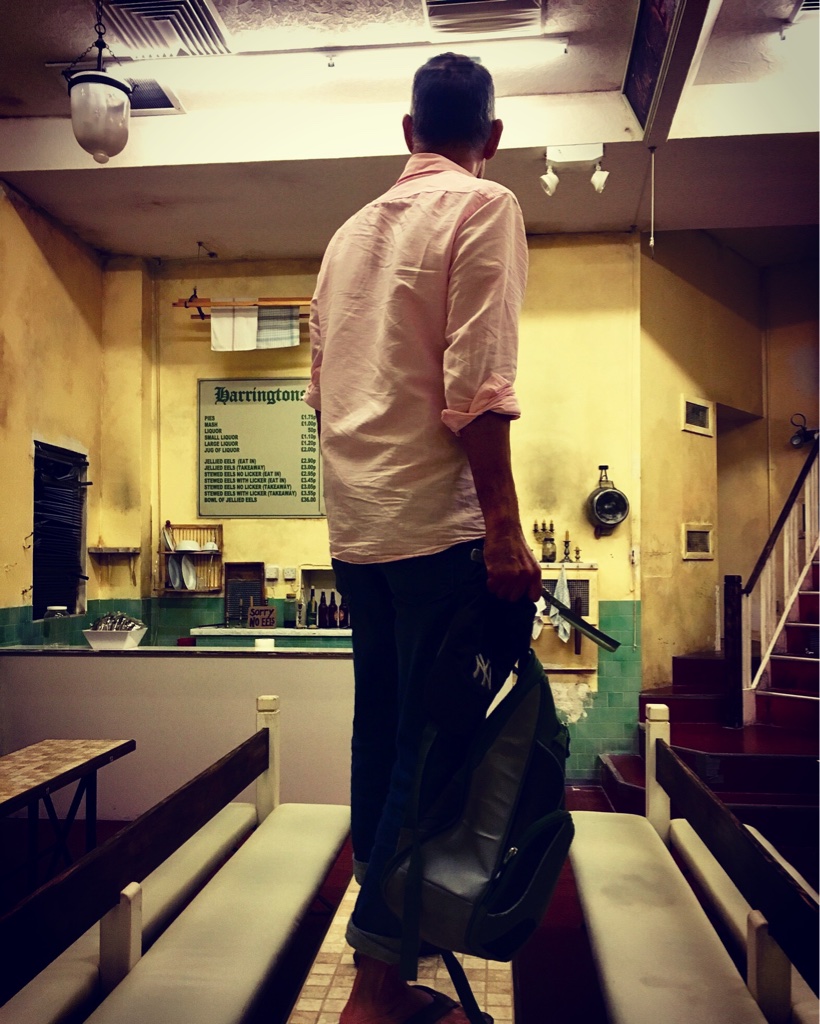
For six months in 2018, I had the great good fortune to be cast in the title role of SWEENEY TODD: THE DEMON BARBER OF FLEET STREET. I stepped into the role, following the footsteps of some pretty brilliant performers – Hugh Panaro preceded me; Norm Lewis before him; and the original Sweeney for this brilliantly conceived and executed Tooting Arts Club production (directed by Bill Buckhurst), Jeremy Secomb. For those reading who aren’t familiar with this version – it was presented in a pie shop. That’s right, a practical restaurant, though “restaurant” would be a generous application of the word. Both site-specific and immersive, the action of the play unfolded in, around and practically on the heads of the audience who sat at benches where most of them had the option of dining on meat pies prior to each performance. The concept of the play was definitely intimate, given the environment, and in execution. Hal Prince’s original (and flawless) iconic operatic approach with its huge cast was gone and instead the ballad was performed by an ensemble of 12 (nine actors, three musicians).
Thrilling would be an understatement, both to watch and to perform. Given the intimacy of the setting the piece was surprisingly more emotionally epic, more dangerous and certainly more moving than any production I’d ever experienced, including Hal Prince’s original production which I’d seen when it was on tour with Angela Lansbury and George Hearn (who had followed in the title role created by Len Cariou on Broadway) way back when. It modulated moods between scary and funny with a deftness that was almost unnoticed, and made me feel like I never knew what was going to happen next. And it was funny! And fun – accessible to the audience in a way I’d never before seen. While watching I realized that the the scope or previous productions had always kept the audience at a remove, in effect shielding them from the humanity at the heart of the story. That, at least was my experience when I saw the show almost a year before being cast in it. I’d been asked if I was interested in auditioning for the role but I thought it would be wise to see this production I’d heard so many sensational things about before committing to doing the work of gearing myself up for an afternoon of being Sweeney.
I’d done the role before, in fact, I’d done the role several times. In 1997, it was the first job I landed after returning home from two years on the road, when I played the Engineer in the second national tour of the original production of MISS SAIGON. It was another bigger than life role, one that gave it a passing technical resemblance to the demon barber himself. But I had no illusions that I might actually book the role. It was being co-produced by Repertory Theatre of St. Louis and Cincinnati Playhouse, two wonderful institutional theaters in the heart of the Midwest, and I couldn’t imagine either company at that time casting an Asian American as Sweeney. Fortunately, I couldn’t have been more wrong, thanks to the artistic directors of the producing theaters, Steve Woolf and Ed Stern, respectively, both of whom were visionary champions of diversity in casting and who subsequently became good friends.
The production itself was something to behold and I couldn’t have been prouder of being a part of it. It had its own voice, and a distinct vibe which suggested a post-apocalyptic bleakness blended into the historical context of Industrial Revolution-era London (the blood red skyline of David Gallos’s stunning 19th-century London suggested a burnt out, ruined city) against which Sweeney’s tragic ballad played out. I recall we had a cast of about fifteen, a huge rotating set piece which doubled as the pie shop and the barber shop, and a terrific barber chair contraption with a chute down which the barbers victims slid down to the fate – just as depicted in the original production. It was, in fact, like most productions, a scaled down version of Hal Prince’s Broadway concept. That’s not to take anything away from Ed’s approach to the piece – in many respects, it was more accessible, with a darker, realistic humanity and less of the grand guingol – penny dreadful tone that characterized the original. Still it shared the notion that this tale meant to say something apocryphal about fate, revenge, morality, society, as if the tale of the man himself was too tragic to believe.
I think in many ways at that time, I was the perfect fit for Ed’s approach, along with the rest of the wonderful company. And I felt like a seamless part of that London skyscape, and as Sweeney I savored every dark angry outburst, every deathly silent stare, every painful wail, every articulated and vengeful swing of the razor – all of it cried out in a desperate kind of personal rage about the universe of injustice he inhabited. And I’m a little embarrassed to admit, it was huge performance! But as unapologetic and maybe even shameless as it may have been, I hope that there never a dishonest note in it.
And besides all this – Holy cow – I was Sweeney Todd! To say a dream had come true doesn’t begin to capture this experience – This was a role that I never would have dared put on my bucket list because the odds that i’d ever be asked to play it were just too outrageous. Yet here I was, in an exquisite production with a remarkable cast, doing the thing I’d been trained to do, expect in a part that so intimidated me to my core I still struggled to believe it. It’s a feeling that’s never left me – one I still felt during my run in the New York revival years later.
But frankly, looking back at it now, as proud as I was of the production, my own work very something that was more performed than acted. I clearly had a lot to prove to myself, and I think as much as anything else, that was my focus. It was also about living in the template most of us assumed was the play – I mean, why argue with success? Sweeney Todd was that angry guy crying out for revenge! The barber chair has this cool slide! Mrs. Lovett is nutty and everyone’s got smudgy make-up! Of course, I’m being glib – but the long and short of it is, if you’ve seen Sweeney Todd on stage, you’ve seen everything I’ve just written down. It doesn’t make it bad, or dishonest, or imitative – it’s not so much that everyone’s trying to copy and improve on Hal Prince’s original concept – it’s just that he created the language that everyone speaks when you do Sweeney. And there’s nothing wrong with that. the same could be said for how I approached the role – that was what spoke to me in the text and the score. And that – a primal vengeful against an unjust world – was the language I was using.
About ten years later, I had the opportunity to revisit Sweeney, this time in Philadelphia, at the Arden Theatre. Terry Nolen’s concept was a ddaring mixture of the operatic tone of the score, with an environmental approach, using the entire theatre space as the playing area, with the show happening all around and amongst the audience members, in the grid above them, underneath the seats, and of course on the stage – where there was a huge central set piece that loomed and rotated and had a barber chair and a slide and blood – you get the idea. And it was thrilling. The mainstage of the Arden was essentially a huge black box, and Terry was able to arrange the audience in a way to most effectively serve his concept and it couldn’t have worked better. The entire auditorium at different moments became a pie shop, the sewers beneath London streets, a factory, Fogg’s Asylum – you never knew where it could go. Additionally, Terry challenged us to be unafraid — all of us — of getting into the faces of the audience and taking them for the ride of their lives, and I’m pleased to look back and say that we did.
But also in retrospect, as original and passionately executed as it was, it was another way into Hal Prince’s Sweeney universe, even if it was an improvement on it. To its considerable credit (and Terry’s, too) the aim was to create an experience for the audience, to get them inside the story of the demon barber and his partner in crime, Mrs. Lovett. This may have been its greatest strength and the thing that, for me, set this Sweeney apart from others I’d seen. And the intervening ten years since my last foray into the pie shop had served me well – I felt this Sweeney was more grave, more dangerous, had a deeper source of pain to fuel his search for revenge and his madness. The years between had also provided me with ample opportunity to work my craft, to become a better actor (I’d hoped), and a little more settled in my life with less to prove, to others but mostly to myself – which is never a bad thing for an actor. Of course, I’m not sure if any of that’s really true – all actors think they’re learning more all the time, at least we say we do. But I’m fairly certain as far as playing Sweeney went, that however I was approaching the role in 2005, I was still speaking the same language I’d been speaking in 1998. Only better.
(Please don’t get me wrong if I’m close to overstating Hal Prince’s concept of the show – It is and always will be Stephen Sondheim’s masterpiece – well, one of them. But the original production – Hal’s concept was in many ways indistinguishable from Sondheim’s work. But given the current variety of invention and success in other versions of the show, it suggests that what we most recall of that original production is Hal’s contribution.)
As I’ve intimated, I couldn’t have been prouder of my work in both productions. In fact, I felt that I’d done Sweeney Todd as well as I could and wasn’t sure I had anything more to say about it. I felt no great drive or need to do it again, and was pretty much convinced that it would be worth doing it if I didn’t have anything new to bring to it, not for me and certainly not for the piece itself.
I was also very skeptical of different concepts of the show. As much as I loved the different approaches I’d experienced personally, the original production remained one of the pivotal moments in my theatre-going life. In fact I’d credit it (and George Hearn’s performance in it) in making me want to be a certain kind of actor – indeed the kind I think I’ve become. I really didn’t want to see any more different, high-concept productions of Sweeney Todd. To my great regret, I missed John Doyle’s reinvention of the piece, though at the time, I couldn’t bring myself to experience it in a way that threatened my sentimental attachment to the original. Consequently I was very skeptical of the immersive pie shop approach when asked to audition for it. It just seemed so precious, so unnecessarily gimmicky to me. Despite its success in London, and the excitement that surrounded the transfer to its off-Broadway home at Barrow Street Theatre (where I’d done a play almost 20 years before), the opening here went pretty much purposefully unnoticed by me. So months later, when the call came in with an appointment to sing for the role, no one was more surprised than me.
I went to see a matinee at Barrow Street on a Saturday. It’s a cliche to say that the moments the lights went down the magic started, but I’d be lying if I said it wasn’t true. I felt like I was seeing something I’d never seen before, and experiencing a narrative I thought I knew but never really understood. It was simply fantastic.

personal photo
I’d pretty much talked myself out of auditioning when I decided that I should at least look at the material they were asking me to do. It was Sweeney’s first scene with Mrs. Lovett, in the pie shop, one I knew very well, when he learns what happened to his wife and daughter during his years of imprisonment. At least I thought I knew it well. Something was different, something had changed in the 13 years since I’d last looked at this script – and it wasn’t the script. It was me. And just as I did while watching the performance a few days before, I felt as though I was experiencing material I’d never encountered until that moment. This was all new. This scene, which always seemed to me to be about the pain of suffering and injustice, was now about something different, something I’d always known was there but was somehow unimportant given how the story was being told – now, it was about loss. Grief. It was very personal. And it wasn’t about Sweeney Todd – indeed, at that moment in the play, I realized, there was no Sweeney Todd. Only a barber named Benjamin Barker. This was his story.
Loss. Grief, Sadness. Maybe those were things that I’d finally experienced in my own life over the years that finally stuck, that I could acknowledge had finally affected or even changed me. The entirety of Sweeney’s tale came down on me like a sudden weight – he wasn’t driven by rage or a need for revenge. He was fueled by the loss of the thing he loved. His story wasn’t tragic; it was just plain sad. And that difference is huge. I realized this was the story I wanted to tell. This was what I wanted to – no – what I needed to bring to it. And so I confirmed my audition and went for it.
I didn’t get it. Nope. They hired Hugh.
Happy ending – six months later, they asked me back and not long after I found myself in the pie shop once again. It was a long lesson, it took 21 years since the first time I wielded the razor, but it was worth the wait. And I realized it wasn’t Sweeney who was back. It was Benjamin Barker.

personal photo
